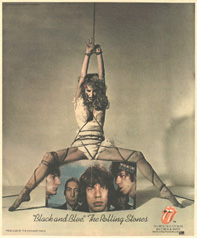![]()
  |

Black and Blue
The Rolling Stones
Rolling Stones Records 79104
Released: April 1976
Chart Peak: #1
Weeks Charted: 24
Certified Platinum: 6/23/76
 By the time the Rolling Stones settled down to record their 24th album, they had lost their second guitarist, but this time he lived to tell the tale. "The last five-and-half years with the Stones have been very exciting and proved to be a most inspiring period," said the prepared statement from Mick Taylor. "And as far as my attitude to the other four members is concerned, it is one of respect for them, both as musicians and people. I have nothing but admiration for the group, but I feel now is the time to move on and do something new."
By the time the Rolling Stones settled down to record their 24th album, they had lost their second guitarist, but this time he lived to tell the tale. "The last five-and-half years with the Stones have been very exciting and proved to be a most inspiring period," said the prepared statement from Mick Taylor. "And as far as my attitude to the other four members is concerned, it is one of respect for them, both as musicians and people. I have nothing but admiration for the group, but I feel now is the time to move on and do something new."
Yet Taylor's statement was only part of the truth, as it has been reported that he was upset that he didn't receive co-writing credits on the Stones songs and was not allowed to fully express himself creatively in the band.
Glyn Johns, who along with his brother Andy worked as engineers on such Stones albums as Sticky Fingers and Exile on Main St., was called to produce the session with Stones Mick Jagger and Keith Richards, who once again received credit under the pseudonym "the Glimmer Twins." Johns recalls, "I agreed to go in with them and produce the album under the condition that if I didn't finish the album with them, I wouldn't receive co-producer credit." By this time Johns had an extensive history with the band -- he was actually the first to record them, although those early sessions were never released.
"The night before we left for Munich to start making the record, Mick Taylor resigned, so they turned up in Germany without a second guitar player," Johns recalls. "As a result, we got on tremendously well and we cut an immense amount of material in an extremely short period of time. It was great for me to be back with them."
 Click image for larger view. |
After breaking for Christmas, the Stones decided to take the mobile unit to Rotterdam, Holland, to complete the album. "They got this hall that was suitable for symphony orchestras, but it was certainly not the right place to make a record, and then they started auditioning people. They were using the recording time to audition guitar players.
Three guitarists who auditioned for the Stones are featured on Black and Blue. Harvey Mandel, from John Mayall's Blues Band, played on "Hot Stuff" and "Memory Motel." Noted session player Wayne Perkins was also featured on the latter track, as well as on "Hand of Fate" and "Fool to Cry," the latter of which went on to become a Billboard top 10 hit. It was ex-Faces guitarist Ronnie Wood, however, who played on "Cherry Oh Baby," "Hey Negrita," and "Crazy Mama," who eventually became Taylor's replacement.
The Stones' lax approach to recording soon wore Johns down. "there was an argument between me and Keith, and I lost my rag. I said my piece and told the Rolling Stones they could go f--- themselves. As far as I was concerned, the record was nearly finished, but then they spent nine months finishing it off." Despite such hassles, Johns still has respect for the Stones. "When they did get it together, they were fantastic and unbeatable," he says.
The record-buying public agreed. In its second week on the chart Black and Blue became the Stones' sixth Number One album.
- Craig Rosen, The Billboard Book of Number One Hits, 1996.
Bonus Reviews!
Rather than trying to take an early stand as to whether or not this is one of the historic landmarks of rock, let us just say that the Stones here have come up with one of their most purely enjoyable albums of the '70s. Immaculate production sound and crisp musicianship are present throughout. But the most striking factor is the LP's near-equal division between the classic pile-driver Stones rock format and highly successful forays into an unusual variety of styles for a Stones LP. There's reggae and a soulful cut with Billy Preston singing with Jagger. Perhaps ultimately most striking of all will prove to be the Bowie-disco "Hot Stuff" that kicks off the album. Best cuts: "Fool To Cry," "Hot Stuff," "Melody," "Crazy Mama."
- Billboard, 1976.
More blatantly imitative of black-music rhythms and styles than any Stones album since December's Children, and also less original (if more humorous) in the transformation, this nevertheless takes genuine risks and suggests a way out of their groove. Lots of good stuff, but the key is "Hot Stuff," pure Ohio-Players-go-to-Kingston and very fine shit, and the high point "Fool to Cry," their best track in four years. Diagnosis: not death by a long shot. A-
- Robert Christgau, Christgau's Record Guide, 1981.
Ron Wood's first album with the Stones finds the band working through a number of reggae and funk-tinged numbers, trying to expand their sound. Consequently, songs are sacrificed for grooves; only the ballads "Memory Motel" and "Fool to Cry" are fully developed, but the grooves that dominate the album are strong enough to make the record successful. * * *
- Stephen Thomas Erlewine, The All-Music Guide to Rock, 1995.
![]() Reader's Comments
Reader's Comments
No comments so far, be the first to comment.